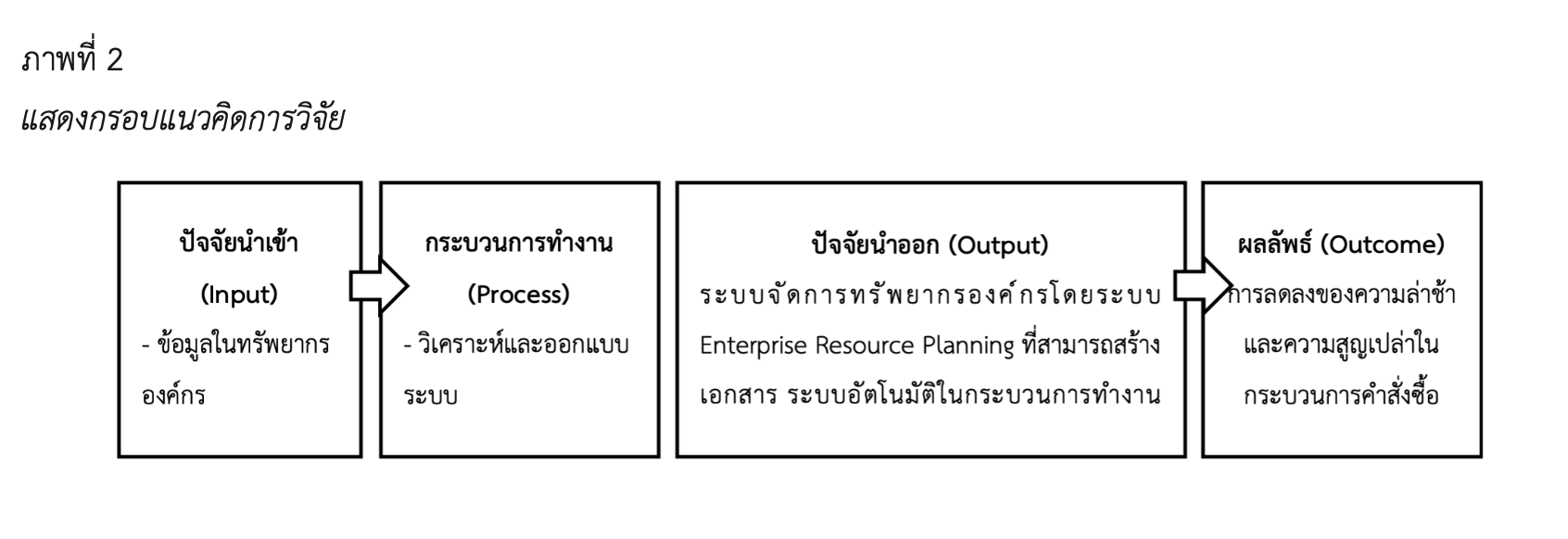WASTE REDUCTION IN THE ORDER MANAGEMENT PROCESS THROUGH ENTERPRISE RESOURCE PLANING: A CASE STUDY OF ABC COMPANY
Main Article Content
Abstract
This research was conducted to study the existing order management process of ABC Company and to reduce the waste occurring in the order management process through the development of an Enterprise Resource Planning (ERP) system, along with proposing its application within the organization. The sample consisted of transaction processing times in the order management process, derived from the production and warehouse management performance report for January 2024, covering a total of 149 orders. The research tools employed include a fishbone diagram, ECRS (Eliminate, Combine, Rearrange, Simplify) analysis, flowchart design, and data flow diagrams and building the ERP system. Descriptive statistics, such as frequency and percentage, were used for analysis.
The study found that:
The company is currently facing ongoing delays in the order management process due to data disconnection between departments, as each department operates with separate systems—such as production and inventory control systems, and off-the-shelf accounting systems. When the systems are not integrated, redundant tasks and inconsistencies occur, leading to delays in communication and duplicated work. The primary cause of waste in the order management process is the lack of integration in the company’s information management systems. Therefore, an analysis and system design were conducted using data flow diagrams, which identified eight key stakeholders involved in the system: customers, sales department, warehouse department, purchasing department, accounting and finance department, human resources department, production department, and transportation department. By applying the ECRS principles, the study successfully reduced waste by optimizing 20 steps in the process. The proposed model for order management led to an improvement in process duration, reducing the time from 263.30 minutes to 137.30 minutes, a reduction of 129.57 minutes per order, representing a 47.94% improvement per order. Upon implementation, the number of delayed orders decreased from 75 to 4, a reduction of 71 orders, or 94.67%. Additionally, the total delay time decreased from 1,964 minutes to 37 minutes, representing a reduction of 1,927 minutes, or 98.12%.
Article Details
References
กฤษฎิมา เบญจประภาพร. (2554). การวางแผนและควบคุมวัสดุโดยใช้ระบบ SAP: กรณีศึกษาบริษัทผลิตสื่อสิ่งพิมพ์ [วิทยานิพนธ์ปริญญามหาบัณฑิต, มหาวิทยาลัยธุรกิจบัณฑิตย์]. https://doi.nrct.go.th/ListDoi/listDetail?Resolve_DOI=10.14458/DPU.the.2011.70
คาซึมะ บัน, และฮิโตชิ อิโต. (2546). สู่การเป็นผู้นำในการใช้ ERP (ฤทธาภรณ์ และคณะ, ผู้แปล). สมาคมส่งเสริมเทคโนโลยี (ไทย-ญี่ปุ่น).
ฝ่ายผลิตและบริหารงานคลังสินค้า กรณีศึกษาบริษัท เอบีซี. (2566). รายงานผลการดำเนินงานการผลิตและบริหารงานคลังสินค้า สิงหาคม 2566. บริษัท เอบีซี.
ฝ่ายผลิตและบริหารงานคลังสินค้า กรณีศึกษาบริษัท เอบีซี. (2567). รายงานผลการดำเนินงานการผลิตและบริหารงานคลังสินค้า มกราคม 2567. บริษัท เอบีซี.
Alsharari, N. M., Al-Shboul, M., & Alteneiji, S. Z. (2020). Implementation of cloud ERP in the SME: Evidence from UAE. Journal of Small Business and Enterprise Development, 27(2), 299-327. https://doi.org/10.1108/JSBED-01-2019-0007:contentReference[oaicite:0]{index=0}
Bocij, P., Greasley, A., & Hickie, S. (2018). Business information systems: Technology, development, and management for the modern business. Pearson.
Bowersox, D. J., Closs, D. J., & Cooper, M. B. (2012). Supply chain logistics management (4th ed.). McGraw-Hill.
Christopher, M. (2016). Logistics & supply chain management. Pearson UK.
Krajewski, L. J., Ritzman, L. P., & Malhotra, M. K. (2019). Operations management: Processes and supply chains (12th ed.). Pearson Education.
Liker, J. K. (2004). The Toyota way: 14 management principles from the world’s greatest manufacturer. McGraw-Hill.
Mentzer, J. T. (2001). Supply chain management. Sage Publications.
Monczka, R., Handfield, R. B., Giunipero, L. C., & Patterson, J. L. (2020). Purchasing and supply chain management (7th ed.). Cengage Learning.
Monk, E., & Wagner, B. (2013). Concepts in enterprise resource planning (4th ed.). Cengage Learning.
Womack, J. P., & Jones, D. T. (1996). Lean thinking: Banish waste and create wealth in your corporation. Simon and Schuster.

